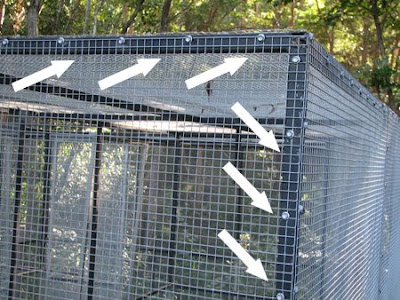I was fortunate enough to have my good friend and brilliant photographer Peter Odekerken stop by yesterday to take a few images. If you're unfamiliar with Peter's work then check out his website at http://www.parrotimages.com.au He will be lecturing on parrot photography at the Parrots 2010 Convention in Brisbane on the first weekend in July - be there good feathered people!
What was great about having Peter take some snapshots is that his camera is able to take up to 9 frames per second, allowing me to analyse the minutiae of what's going on when I'm working with a bird. As I discussed in my previous training diary entry about `Maya' our Green-winged Macaw, this is a bird that is highly averse to hands and is significantly lacking in trust towards humans. She was almost completely parent raised and had to endure an 8 week period of being force fed via gavage tube whilst being weaned due to her parent's deserting her nest. As you can imagine, daily restraints and force feeding episodes completely eroded this birds acceptance of hands. We've been rebuilding the trust account with her, slowly, and at her pace. It's been a remarkable learning experience and a very good opportunity for me to get back to being challenged in regards to the clarity of my antecedent arrangement, communication, reinforcement delivery, and most importantly - `patience' when training.
Here's a couple of cool things I picked up when looking back at the images Peter took...
Firstly - what's wrong with the picture below? Note the posture of Maya upon the presentation of the hand cue as I am getting ready to request a step up. A keen trainer will notice that she's leaning slightly away from the hand, is extremely upright, and her foot is held up more defensively rather than a desirably relaxed position. Her body weight is shifted away from the hand rather than towards it, thus taking any possible momentum towards a step up out of the equation. Acknowledging these subtleties in body language is what sensitive training is all about. What many owners are inclined to do is to continue with the cue, possibly coerce the bird into stepping up, and as a result, achieve the goal without their being a true `choice' and decision making process afforded to the bird. I backed out, allowed her to re-perch, relax, re-evaluate, and hopefully present some more confident body positioning upon the presentation of a new cue.
Now have a look at the next image below. What's wrong here? The body positioning is better and the weight shift is more indicative of confident movement towards the hand but... that hand position is all wrong. The last thing I want Maya to do is to place her right foot at the end of my hand and leave no room for her left foot to follow. This is a bird that has zero tolerance for an unstable perching surface - particularly when that is a human hand. Time to remove the cue before the foot touches the hand, reinforce the confident movement towards the hand and rebuild the momentum by repositioning my hand to better set her up to succeed in achieving the goal of both feet on my arm.
The image following shows where I needed her right foot to be placed - on my wrist and thus allowing plenty of room for her left foot to follow and fall into position for a comfortable step up.
As you can see, she's building her confidence week by week. Parent raised Macaw folks. Very humbling.









